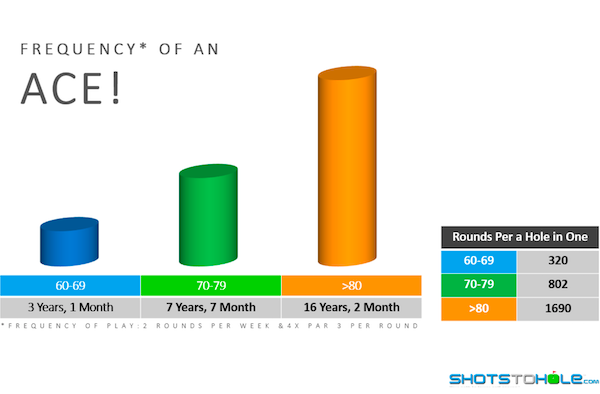Welcome to Shaving Strokes, a GOLF.com series in which we’re sharing improvements, learnings and takeaways from amateur golfers just like you — including some of the speed bumps and challenges they faced along the way.
If there’s one thing every golfer chases until the end of time, it’s a hole-in-one. That’s because, unlike hitting a homer in baseball or throwing a 50-yard bomb in football, holing an ace can be achieved by any level of golfer.
For example, last summer I was playing with a couple randoms at a par-3 course near my house. One of the guys was a late-40s, somewhat unathletic-looking guy, who told me he had just picked up golf and had only played two previous rounds.
Without being too harsh, I have to admit: The guy had the ugliest swing I’ve ever seen. He didn’t rotate at all, and didn’t even bring the club all the way back, sort of pushing every single shot as if he were using a putting stroke.
Now you know where this is going, right?
Should a hole-in-one on a short par 3 course count as an ace? Golfers are tornBy: Nick Dimengo
We’re standing on the tee box of a 115-yard hole, and as he hits his ball, it rolls about 50 yards, skips a little bit more on the grass, passes over the front edge of the green and it just beelines right into the cup. Yep, he just got a hole-in-one — and maybe the most improbable ace at that!
The group celebrated with him, but he was so new at golf that he didn’t realize how big of a deal it really was, treating it more like an ace in putt-putt. Hell, he didn’t even pose for a customary photo or anything.
This got me thinking: How likely is a hole-in-one for a golfer?
Instead of going down an Internet rabbit hole to dig up unreliable info, I reached out to GOLF Top 100 Teacher Liam Mucklow, who uses cold hard data from a site called ShotsToHole.com to deliver stats compiled by its co-founder, Stuart Leong.
As you’ll see below, ShotsToHole provided a graph to display just how common an ace is for certain handicap levels. Mucklow then breaks down the data and provides some commentary that’s both fun (and helpful).
So take a look and see when you can (maybe, possibly, hopefully) expect to hit a hole-in-one — but don’t hold your breath it’ll happen. I’ve been playing this whacky game for 28 years and have yet to even come close.
Was your hole-in-one lucky, or were you due?
“One of the most unique things about golf is how players of all different levels can compete with one another on the same course at the same time,” says Mucklow. “Just because I’m a pro and you’re a mid-handicapper doesn’t mean you may not hit a better shot than me during a round.
“There will likely be at least one time where you ‘beat the pro,’ meaning you buried an 8-foot putt or got closer to the pin on a par-3.”
As any player can attest, this is part of the intrigue of golf, with these fun stories typically talked about over a few drinks following a round together.
There’s no better story than describing a hole-in-one, though.
But how realistic is it to believe that you (yes, you, the high-handicapper!) can actually get one? Thanks to the data from Leong’s ShotsToHole — which broke down thousands of on-course performance data from players of all levels — we have an idea.

As I described earlier, I was playing with a beginner golfer who sunk an ace in the summer of 2023. But despite being a high-handicapper with little playing experience, he accomplished something that every golfer strives for.
Given his ability, the info from ShotsToHole suggests that the same guy shouldn’t expect his next hole-in-one to come until 2039 — or nearly 1,700 rounds of golf later!
Our most-read rules question of the year involved an intriguing hole-in-one conundrumBy: Jessica Marksbury
On the contrary, if you’re a scratch golfer who shoots in the 70s, the average hole-in-one comes about every seven years; or after 802 rounds. To break that down, you’d have to average about 106 rounds each year — or about 2 rounds every week for the next 7.5 years — to keep with that pace. Better get to practicing!
Finally, the best players in the world — ones who shoot 60-69 — can expect an ace about every three years. So even superb ball-strikers aren’t holing it out nearly as much as many golfers might think.
While this data is far from an exact science, it’s a fun way to use real-life golf data to highlight just how realistic it is to expect getting a hole-in-one. So the next time you’re standing on a par-3 tee box, use this info to determine if you’re lucky or if you’re due.













